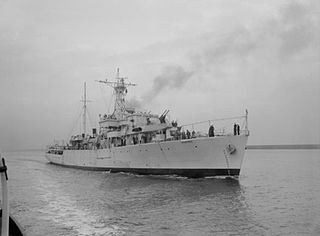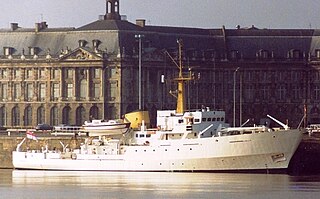
HMS Enterprise, the tenth ship to bear this name, is a multi-role survey vessel - hydrographic oceanographic (SVHO) of the Royal Navy. She has a sister ship, HMS Echo, and together they make up the Echo class of survey vessels.

HMS Herald was a Hecla-class ocean survey ship that served with the Royal Navy during both the Falklands War and Gulf War.
Five ships of the Royal Navy have been named HMS Herald:

The United Kingdom Hydrographic Office (UKHO) is the UK's agency for providing hydrographic and marine geospatial data to mariners and maritime organisations across the world. The UKHO is a trading fund of the Ministry of Defence (MoD) and is located in Taunton, Somerset, with a workforce of approximately 900 staff.
Seven vessels of the British Royal Navy have been named HMS Bulldog, after the bulldog:

HMS Waterwitch was a British hydrographic survey vessel active in eastern Asian waters from 1894 to 1912. She was a wooden vessel, purchased from a private owner specifically for survey work. She was lost in a collision in Singapore harbour in 1912.

HMS Surprise was a Bay-class anti-aircraft frigate of the British Royal Navy. In commission from 1946 to 1965, she served in the Mediterranean Fleet as a Despatch Vessel for the Commander-in-Chief. Although principally employed for the use as a yacht by the CinC, Surprise was also deployed in its operational role as an anti-aircraft frigate. The archaic term "Despatch Vessel" was replaced by "Flag Frigate" in 1961.

HMS Cook was a Bay-class frigate of the Royal Navy, named for the explorer James Cook, which served as a survey ship, mostly in the Pacific Ocean from 1950 until 1964.
HMS Dampier was a Bay-class anti-aircraft frigate of the British Royal Navy, named after the explorer, author and privateer, William Dampier (1652–1715). The ship was in commission from 1948 to 1968, spending her entire career based at Singapore, carrying out survey work.
HMS Waterwitch has been the name of several Royal Navy vessels:

HMS Beagle was a Bulldog class coastal survey vessel of the Royal Navy and was the ninth to bear the name.
HMNZS Monowai (A06) was a hydrographic survey vessel of the Royal New Zealand Navy (RNZN). Built in 1960, the ship was originally used as a civilian supply and passenger vessel by the New Zealand Government, under the name GMV Moana Roa, before being acquired by the RNZN in 1977. She remained in RNZN service until 1997, performing various duties such as coastal surveying, resupply, and surveillance. After being decommissioned she was sold to civilian operators in Britain in 1998 for conversion to a cruise ship, but was found unsuitable for the role and eventually sent to Spanish shipbreakers in 2002.

HMS Scott (J79) was a Halcyon-class minesweeper of the British Royal Navy completed as an unarmed survey ship with an enlarged bridge and a large chart room abaft the extended forecastle deck. She served through World War II and the two following decades.
The Bulldog class was a four ship class of survey vessels in service with the Royal Navy from the late 1960s until the start of the 21st century. Initially designed with service overseas in mind, they spent most of their careers off the British coast. A fifth ship was subsequently built to a modified design to support them in their activities. Decommissioned and sold off at the end of the 20th and start of the 21st centuries, they have continued in service as civilian vessels, with some being converted to private yachts and others entering other commercial sectors.

HMS Sealark was a Royal Navy vessel used primarily for hydrographic survey work. She was originally a luxurious private auxiliary steam yacht for a number of wealthy owners and in 1903 was acquired by the Royal Navy, serving until 1914. She was sold to James Patrick Steamships Ltd and converted to a merchant ship for the Australian coast and finally hulked in 1924.

HMS Buttercup was a Flower-class corvette built for the Royal Navy. She served during the Second World War first as part of the Free Belgian section of the Royal Navy (RNSB), and then later as part of the Royal Norwegian Navy. Between 1946 and 1957 she served as HNoMS Nordyn. The Norwegian government then sold her and she became the whaler Thoris until she was broken up in 1969.

HMSAS Protea was a survey ship of the South African Navy. The ship was originally built as a Flower-class corvette for the Royal Navy during World War II named Rockrose and was sold to South Africa after the war. Rockrose was initially assigned to convoy escort duties in the North Atlantic after her completion in 1941, but was later transferred to South African waters and then to the Far East with the same mission. She returned home in 1945 and was paid off.

HMSAS Natal was one of three Loch-class frigates in the South African Navy (SAN). It was built as HMS Loch Cree (K430) for the Royal Navy during World War II, but was transferred to the SAN before completion in 1945 and renamed as HMSAS Natal. Just hours after finishing fitting out, the ship sank a German submarine off the coast of Scotland in early 1945. It was assigned convoy escort duties for the remaining few months of the war in Europe. Natal had her anti-aircraft armament reinforced for service in the Far East after arriving in South Africa in June. In September–October, the ship participated in the reoccupation of British Malaya before returning home the following month.











